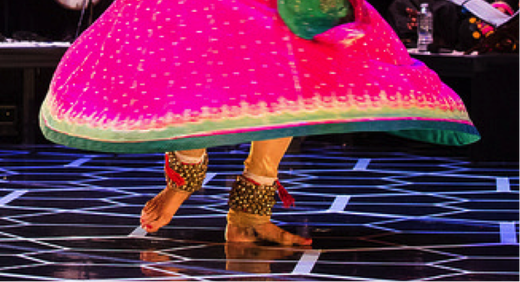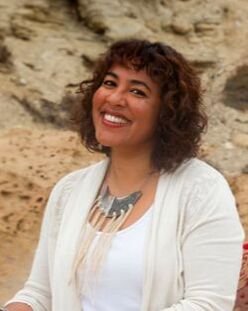|
When I was 20, I was bitten by the classical Indian music and dance bug. Before I knew it, I found myself with a one-way ticket out to Northern California to study with one of the last living masters* of Kathak. Kathak is a dance discipline made up of mathematically precise footwork, swift pirouettes and storytelling. Our teacher was always known for his speed and agility, training us with the utmost rigor and repetition. When people would visit the class, he would pride himself on how hard he’d work us, often pushing us, for example, to execute 108 swift pirouettes in a row without pause. At one point, I remember I spun so out of control I knocked over the halogen lamp in the Fulton and 3rd Ashram in San Francisco where we used to train. Speed and fierceness were high values, and to just keep going, no matter what, was often the lesson. There were times we’d be on a roll, and nothing could stand in our way, egos flying high, adrenaline pumping from the percussive beats and all-around good workout. And then, he’d do the one thing that would completely fuck our shit up: He’d slow everything down. All of a sudden, everything we had trained our bodies to do in relation to executing a composition at a certain speed went out the door. If I had to give you a surfing metaphor for what this was like, it was akin to surfing a thin, hollow wave over a pure reef break on a shortboard, feeling the split second stability of the board that a powerful wave might offer on takeoff, and then suddenly finding yourself on a completely different wave - one that is slow, flat, lazy, and weak, but having to surf with the same board - without being allowed to paddle. All of a sudden, with everything weaker and slower, the board feels wobbly in the weak surf. But now you need some type of precision and skill to make it work in those conditions. Deep inside, I knew this was my teacher’s way of truly testing how well we knew the compositions and how solid of a grasp we had of taal (rhythm), one of the defining virtues on which the whole classical North Indian music structure is based. If the tempo were slowed down, we really HAD to understand the composition, in a totally different way. We had to know precisely where each beat of the composition would land in the cycle of rhythm AND make conscious adjustments to the composition and relate it differently to the underlying rhythmic cycle. We suddenly needed to shift from unconscious competence into a space of being conscious of what we were doing. This required us to be ever more precise given the space of in-between we were now given. Aside from the “be prepared for what life may throw at you” lesson, there was another lesson in this, too. First, a little neuroscience. Let’s start with brain waves. We have 5 known speeds of brain waves—beta, alpha, theta, delta and gamma. Whether we are mentally active, resting or asleep, our brain always has some level of electrical activity. Beta, for example, is where we function most of the day when we are “doing” something, like when we are in our task-positive network. Delta is our slowest wavelength, generated in dreamless sleep and in the deepest of meditation. As my coaching colleague pointed out, the slower our brain waves, the more time we have between thoughts (just as we have more time between beats in a composition when the tempo slows.) The more mindful we can be about our thoughts and actions, the more conscious we become of them. But wait! There’s more! --The slower the brain waves, the more the right and left hemispheres of the brain communicate! So when the tempo of life slows, it forces more awareness and consciousness AND, quite possibly, a more optimal environment for brain integration. I know - Holy Mother of Kali! In thinking about this lesson from classical Indian dance, I couldn’t help but wonder what we miss as leaders when we don’t slow down. By slowing down, we are literally allowing more space between thoughts and creating a more optimal internal environment for conscious, thoughtful decision making. In fact, if you think about it, slowness has virtues not just in the leadership realm. I recently decided to slow down my eating and to chew as much as possible, to consciously be aware of the food I was eating to nurture my body. As a result, my entire experience of eating changed. For one, I become fuller with less food AND I actually enjoy the food more, reveling in every bite and taste. I am also WAY more present to the eating experience. I do not mean to say that speed doesn’t have its virtues, or that quick decisions are always bad, nor do I mean to imply to ignore our intuitive hits. However, to slow down a process while still maintaining balance and grace is something of an art. It requires awareness, consciousness and precision. In the case of dance, it was the necessary training ground that would serve to distinguish the technique and ability of a dance practitioner from the nuances and subtleties of a well developed artist. Imagine what we’re missing when we’re always doing everything fast—from dating, to eating, to running a business, to surfing only fast waves, or dancing only fast compositions. We’re short-changing the many capabilities, perspectives and details the structure of our consciousness offers, limiting how we see, feel and experience the world around us. We’re missing out on this rich space of "in between", and on the insights that come from having to break something down we know so well, and to be in it from a totally difference reference point. It’s no coincidence there is a surge of interest in Eastern traditions that have practices that slow us down. From yoga to meditation to, yes, classical Indian dance and music. These are not just new-agey, hippie-dippie things. We’re in a moment in our culture when we are actively seeking slow. In doing so, we are not just building optimal environments for better, more integrated brains, but, in my opinion, honing real leadership tools. So to leaders out there, I challenge you to slow things down, but to first start with slowing down your own thoughts. You may, in the end, make better decisions and contribute to a more conscious and mindful world. Where do you need to slow it down a notch? What takes you to slow? * The late Pandit Chitresh Das, master Kathak artist, teacher, and performer not only left behind a legacy of timeless teachings in his craft, but patterned the minds of those he touched deeply, cultivating new generations of artists, activists, thinkers, and leaders who continue to be inspired by his lessons and work.
5 Comments
|
AuthorFarhana Huq Archives
June 2023
Categories
All
|
Copyright 2014-2024 Surf Life Executive Coaching



 RSS Feed
RSS Feed